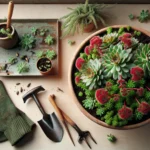Introduction to Sedum Ternatum
Welcome to the captivating world of Sedum ternatum, a resilient gem nestled among the vast diversity of the plant kingdom. This sturdy groundcover, also referred to as woodland stonecrop, originates from the shaded nooks and crannies of Eastern North American forests. Let’s dig into the roots of its popularity and unveil why it has become a go-to choice for gardeners seeking a blend of beauty and tenacity.
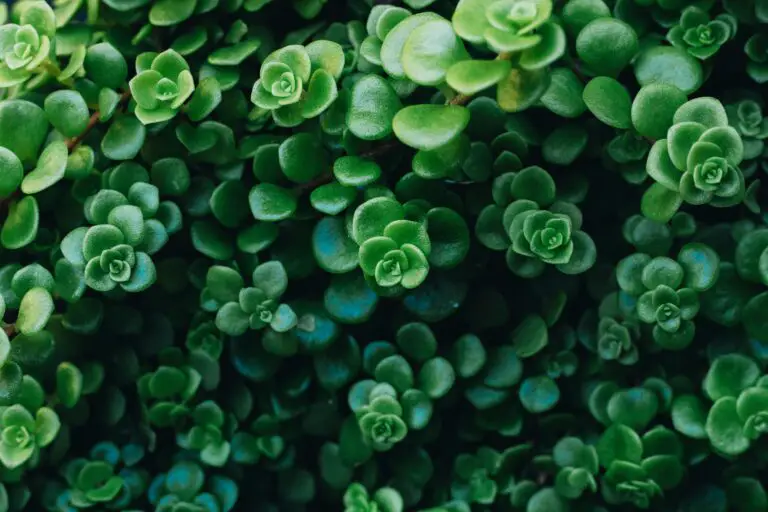
Renowned for its ability to thrive in the dappled light under canopy trees, Sedum ternatum displays an unmatched adaptability to challenging growing conditions. Unlike its sun-loving cousins in the Sedum family, this species relishes the cool retreat provided by shade – a trait that makes it a precious find for those shadowy garden spots where other plants might falter.
Its foliage forms a lush tapestry across the soil, with delicate, star-shaped flowers blossoming in the spring to add a sprinkle of white splendor to the garden. This enchanting spectacle is not just a visual delight but also an ecological boon, creating a sanctuary for beneficial insects. Discover more about the enchanting world of succulents and their unique types on our dedicated page.
So, are you ready to be swayed by the understated elegance of Sedum ternatum? Embrace it in your garden and witness a remarkable transformation as this humble stonecrop infuses the shade with its evergreen lure and resilient spirit.
Distinctive Characteristics
What truly makes Sedum ternatum a standout among the succulent community and ground covers? Let’s unearth the essence of this botanical gem and learn why it’s much more than just a pretty face in the natural world.
Sedum ternatum, affectionately known as the woodland stonecrop, brings a unique edge to the natural tapestry of your garden. This sedum species is a departure from the sun-loving succulents we’ve come to know. It defies the norm, flourishing even in the dappled sunlight of shady retreats. Gardeners revel in the joy of its versatility, as it gracefully embraces both the cozy corners of a shade garden and the intricate patterns of stone pathways.
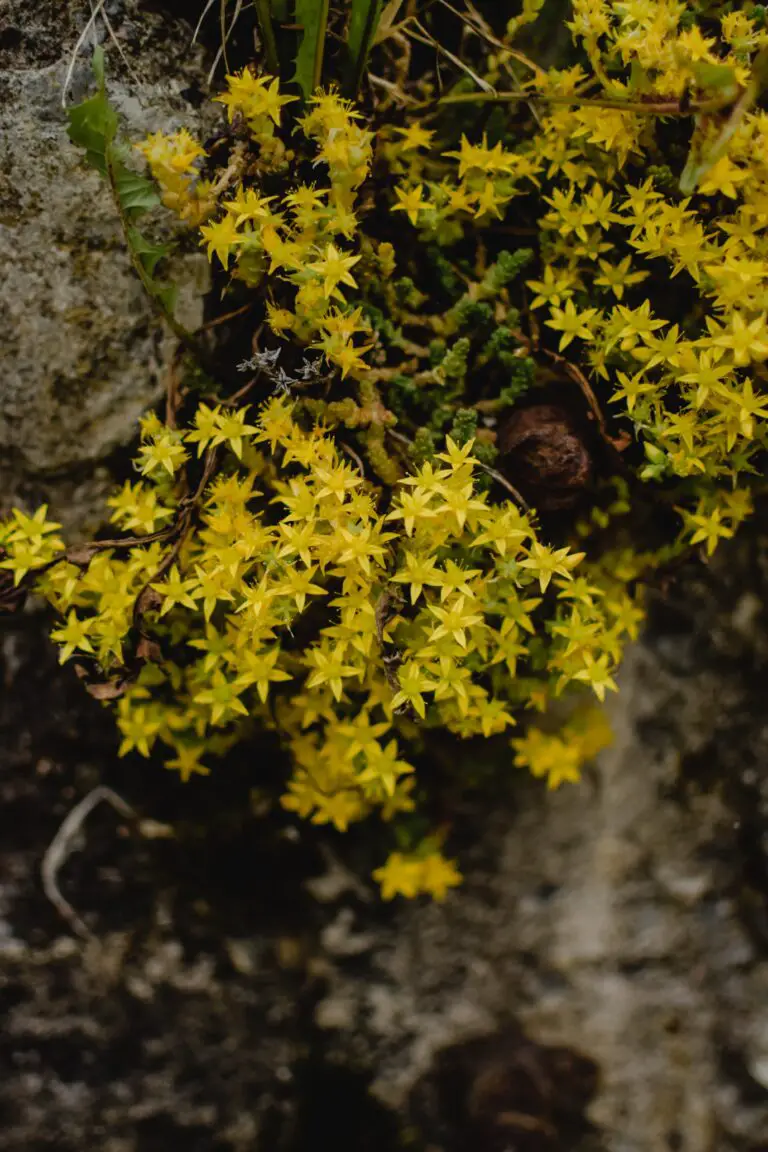
Characterized by its star-shaped, white flowers that bloom in spring, Sedum ternatum adds a whimsical contrast to its shaded green canvas. But it’s not just a springtime marvel. It remains robust and engaging throughout the seasons with its evergreen foliage, creating a year-round carpet of texture and color that’s both ornamental and functional.
Its sturdy stems and fleshy, succulent leaves are structured to retain moisture, making it a resilient selection for rocky or dry locations. In fact, Sedum ternatum is known to thrive on neglect, adapting well to diverse environments with minimal fuss. It’s no surprise that this versatile sedum often finds its way into rock gardens and succulent soil mixes, contributing to the intricate ecosystem with its low-growing habit and spreading nature.
But it’s not just about survival; Sedum ternatum brings an aesthetic appeal that’s both understated and impactful. Its distinctive foliage, ranging from bright green in spring to deep, rich tones in fall, weaves a visual narrative through the months. The petite and picturesque clusters of blooms become the cherry on top, pulling in pollinators and enlivening the space with a dynamic natural rhythm.
Whether carpeting the base of a deciduous tree or softening the edges of hardscape elements, Sedum ternatum is more than a mere ground cover; it’s a testament to the beauty and resilience that can be found in nature’s adaptability. It’s a remarkable player in the ecosystem and an aesthetic genius in landscape design, proving that even the smallest plants can make the most significant impact.
Optimal Growing Conditions
Imagine coaxing a lush carpet of Sedum ternatum, also known as Woodland Stonecrop, to grace your garden with its delicate, starry blooms and verdant leaves! As a fervent ally in your pursuit of a green oasis, let’s explore the utopian trinity of light, soil, and water that will usher this versatile plant into its full glory.
Let’s kick things off with a spotlight on “light”. Despite their hardy nature, these shade-loving troopers prefer the dappled light akin to their native woodland roosts. Full sun brings them dismay, so offer a canopy of tender care with a gentle sun-kissed embrace or a veil of partial shade. It’s as if they are cloaked in theleafy embrace of taller garden companions or nestled under a loosely woven sun hat.
The perfect soil for Sedum ternatum is one that whispers tales of well-drained woods. Aim for an open-textured medium that accommodates air and moisture without holding them too close for comfort. A potting mix for succulents or cactus, with a smattering of organic matter, paves the path for their prosperity. Just like a sponge that holds just enough water to quench your thirst without dripping all over your countertop, the soil should moisten their roots while avoiding sogginess.
When it comes to aqua vitae, consistency is key. These plants are no gluttons for moisture, yet they appreciate a steady sip, especially during dry spells. Think of watering like a moderated watering can’s sprinkle; it should kiss the earth tenderly, providing just enough lifeblood to maintain a comfortable humidity level around the plants. Overindulgence in water might drown their spirits, leading to the dreaded root rot.
Adhering to these nurturing nuances, your Sedum ternatum will not only survive, but thrive, sculpting an evergreen tapestry that interplays with the stones and shadows of your garden scape. And if you’re eager to delve deeper into the succulent sanctuary, explore our comprehensive guide to succulent soil and revel in the splendor of these versatile beauties.

Planting Guide and Techniques
Welcome, fellow shade gardeners! You’re about to embark on a journey that will bring a splash of verdant life to those dim nooks of your garden. We’re gearing up to plant Sedum ternatum, a groundcover gem that revels in the out-of-sunshine spots and clings to stony inclines like a botanical superhero. Let’s delve into the nitty-gritty and transform that shaded stone into a lush landscape!
Spot the Perfect Site
First things first, we’ve got to capture that primo location! Look for an area that’s more about the chill vibes than the suntan; think dappled sunlight peeping through leafy canopies. Sedum ternatum thrives in part to full shade, with its roots eagerly spreading in cool, moist soil. A little tip – if you’ve got a garden with naturally moist conditions or a shaded rockery, you’re already halfway to hosta…I mean, to having the ideal spot!
Preparing Your Stage
Before our little green thespians take their root, we’d better prep their stage. Ensure the soil is well-draining; soggy feet are no-go for our sedum stars. Enrich that earthy mix with organic matter like compost. Not only is it like a nutrient-packed smoothie for plants, but it also improves soil structure – giving those roots the firm handshake they deserve upon moving in.
Laying the Groundwork
Now let’s talk about laying the groundwork – literally! With shovel in hand and determination in your heart, it’s time to dig. Aim for a hole that’s just deep enough to snuggle in the root ball comfortably. And yet, we’re not seeking the depth of Hades here; keep it cozy, not cavernous. Spacing is the social dance of gardening, so give each plant about 6 to 12 inches to foxtrot – or, in this case, photosynthesize.
The Grand Planting
Here’s where the magic happens. Hold your Sedum ternatum like a precious relic and gently nestle it into the hole you crafted with such loving care. Backfill with soil, lightly tamping down to remove those pesky air pockets that roots loathe. And now, the pièce de résistance – water it like you’re baptizing it into your garden domain. Steady, even watering at the start will forge a bond between plant and place so unbreakable, you’d think they grew up together!

Encore! Give it Some TLC
Of course, the performance doesn’t end once the curtain of soil closes. Keep a keen eye on your emerald ensemble; they’ll need a bit of TLC post-planting. Watch water levels – aim for moist, never drenched. A mulch encore can’t hurt, acting as the cozy blanket that tucks them in and keeps the surrounding soil temptingly temperate. In no time, your Sedum ternatum will be playing the lead role in your garden’s shade theatre!
Congratulations, green-thumbed virtuoso! You’ve transformed the reluctant corners of your garden into a scenic retreat with your new Sedum ternatum installation. Remember, every stone and shadowy plot is an opportunity for life, texture, and serene green to take hold. Let’s garden with gusto!
Maintenance and Care Tips for Sedum Ternatum
Sedum ternatum, commonly known as Woodland Stonecrop, isn’t just a pretty face in the shade garden; it’s also a rugged survivor, capable of withstanding neglect once established. Yet, to truly allow your Sedum ternatum to flourish, a little TLC goes a long way. Here’s how to ensure your plants stay as splendid as the rest of your garden.
Watering Wisdom for Woodland Stonecrop
Watering is crucial when your Sedum ternatum is getting settled. Initially, keep the soil consistently moist but never waterlogged. Once established, they embody the ‘set it and forget it’ philosophy, especially in areas with regular rainfall. In dryer zones, a weekly watering during the growing season helps keep them plump and happy.
Here’s an insightful guide on watering schedules, capturing the essence of balance needed for these succulents.
Pruning Practices
Pruning a Sedum ternatum isn’t about cutting back; it’s about encouraging growth. By pinching back the tips in early spring, you signal your plant to become fuller and more robust. Snip off any dead or damaged parts to keep disease at bay and promote a healthy growing environment.
In the real-life gardens I’ve visited, those that show off the fullest, most verdant Sedum ternatum are the ones where gardeners aren’t afraid to give their plants a seasonal haircut.
Seasonal Sensibilities
Spring awakening or fall preparation, every season brings something new for your Sedum ternatum. In spring, clear away old growth and give a balanced fertilizer to kick-start the season. Come fall, while your Sedum is winding down, it’s time to ensure any fallen leaves are cleared to prevent rot and fungal diseases.
Rain or shine, your Sedum ternatum will show its appreciation for your efforts through its lush, star-shaped blooms and vigorous foliage.

Remember, while caring for Sedum tertantum offers a generous margin for error, attentiveness reaps aesthetic and horticultural rewards. So, roll up your sleeves and enjoy the gratifying process of nurturing your touch of shade and stone.
Pest and Disease Management for Sedum Ternatum
Imagine you’ve created a serene shade garden, complete with the lush, evergreen carpet of Sedum ternatum. It’s the envy of the neighborhood—until unwanted visitors arrive. Yes, we’re talking about pests and diseases that can sneak up on your serene scape. But fear not! Managing these uninvited guests can be done with environmentally friendly strategies, and we’re here to guide you through it.
Common Culprits: Identifying Pests
First off, let’s address the tiny troublemakers. Aphids and mealybugs might be small, but they pack a punch by sucking the sap from your plants. Picture this: a cluster of aphids, huddled under a leaf, draining the life out your Sedum ternatum. Not on our watch! You can send these pests packing by releasing their natural enemies—ladybugs and lacewings—right into your garden. It’s like calling in the superheroes of the bug world to save the day!
The Disease Dilemma: Fungal Foes
Next, there’s the silent spreader of sorrow: fungal diseases. Everything is fine one day, and then, bam! Powdery mildew appears like a ghostly film over your sedum’s leaves. And let’s not forget root rot, lurking beneath the soil, waiting to pounce on overwatered plants. To combat these, think like a detective. Eliminate excess moisture and improve air circulation. Perhaps a pine needle mulch can be the perfect sidekick, offering a cozy mulch blanket that still lets your plants breathe.
Unfortunately, there is no video available to show you the process, but picture yourself as the guardian of your garden. With these eco-friendly methods, you become the hero, turning your green haven into a fortress against pests and diseases. Your Sedum ternatum will thrive, creating a stone-cold defense against the elements, making your shade garden a splendor once again.
Landscape and Design Ideas
Picture this: a tranquil patch of shade in your garden, a serene oasis where the hustle and bustle of the world fades to a mere whisper. Now, imagine a carpet of greenery studded with star-shaped blooms, thriving amidst the cool, calm enclave. This is the magic that Sedum ternatum, commonly known as woodland stonecrop, can bring to your landscape.

Not every plant can boast such a verdant flourish in the dimmer corners of a garden, but the Sedum ternatum is a true champion of the shade. With its lush, evergreen foliage and frothy white blossoms come spring, this groundcover is a delight for those looking to breathe life into less sunny spots.
Harmony with Hardy Stones
One of the most enchanting features of Sedum ternatum is how beautifully it nestles into rockeries and stone paths. The soft texture of its foliage juxtaposed with the hard lines of stones creates a visual and tactile contrast that engages the senses. Picture them spilling over a stacked-stone wall or edging a gravel pathway, creating a natural, yet refined boundary.
Companion Planting for Contrast
Envision pairing the woodland stonecrop with taller, deep-green ferns or the dark, dramatic leaves of Heuchera for a mesmerizing contrast. This plant doesn’t compete for attention; it complements. It’s the ultimate team player in your garden’s ensemble, adding a touch of elegance to its botanical companions.
A Tapestry of Texture
Landscapers adore Sedum ternatum for the way it weaves texture throughout garden beds. When planted en masse, it serves as a living mulch, keeping the soil cool and moist while adding an understated sparkle to your outdoor space. Intersperse it among your perennials to watch how it completes the garden like the final piece of a jigsaw puzzle.
It’s not just in appearance that these unassuming beauties cast their spell; they’re also a boon for pollinators. Butterflies and bees can’t resist their charm—an added bonus to their already substantial list of credentials. So, when you choose to adorn your garden with Sedum ternatum, you’re not just adding a plant; you’re curating an ecosystem.
The allure of Sedum ternatum lies not only in its beauty but in its ability to transform a garden space into a tapestry of textures, colors, and life. Embrace this shade-loving splendor and watch as your garden becomes a sanctuary for both the eye and the spirit.
Propagating Sedum Ternatum
Sedum ternatum, commonly known as woodland stonecrop, is a robust and versatile succulent that adds a touch of greenery to shaded stone paths and garden nooks. If you’ve been marveling at its star-shaped white blooms and looking to spread the joy, what better way to do so than by propagating your own? And trust me, it’s as gratifying as seeing a shy plant bloom under the canopy. It’s a piece of cake—or should we say, a leaf off the old block?
Leaf Cuttings: A Simple Snip
One of the simplest methods to propagate this shade-loving friend is through leaf cuttings. Just like cutting a piece of your favorite cake to savor later, you can snip off a healthy leaf, making sure to get a bit of stem too. Pop it into some moist potting mix, and with a touch of patience, tiny roots will reach out, and a new plant will emerge. It’s a magical transformation, akin to a caterpillar turning into a butterfly.
Divisions: Doubling the Delight
Another unobtrusive way to multiply your sedum ternatum is by division. Imagine your plant as a flourishing metropolis, and you’re the urban planner splitting it into thriving neighborhoods. You gently dig around the mother plant, lift it out and tease apart sections, each with roots and leaves intact. Each section becomes a potential new suburb in your garden, ready to establish itself and grow.
Dividing your sedum is like hosting a potluck—each division offers something to the table. Before you know it, you have a garden full of sedum ternatum, each piece with its own story to tell, its own journey from a humble section to a full-blown spectacle of nature’s splendor.
Stem Cuttings: The Quick Change Artists
For those who delight in more instantaneous results, stem cuttings are your go-to. Each piece, about 2 to 3 inches long, is a potential sedum in the making. Like a stage magician pulling a rabbit out of a hat, you’ll see visible change in just a few weeks. Plunge those stems into a waiting mix of soil and sand, and keep them in dappled light. With a spot of watering, roots will sprout, and soon enough fresh green leaves will unfurl—a true spectacle!
With stem cuttings, you’re not just a gardener; you’re a creator of abundant life, turning what looks like mere stems into verdant cascades of green that beautify your shadowed retreats and stone-laden panoramas.
Whether you share these green gems with friends or create a sea of sedum ternatum that’s the envy of any shade garden aficionado, know that propagation is at your fingertips. As you tuck those leaf, stem, or divided pieces into the soil, you’re not just growing plants; you’re crafting stories, stirring life within the earth—one leaf, one stem, one division at a time.
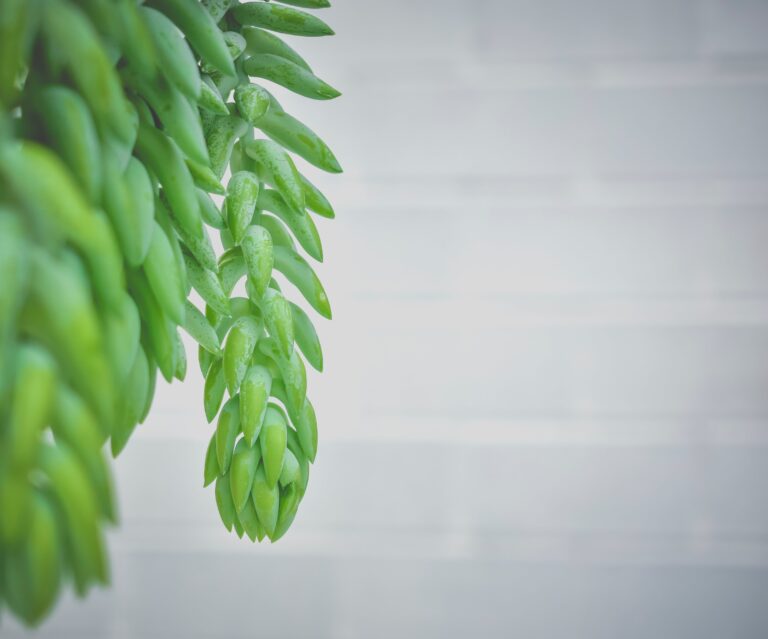
Environmental Benefits and Sustainability
The whispering sounds of a verdant garden speak volumes about its health and the ecological harmony within. A hardy yet delicate slate-blue carpet underfoot, Sedum ternatum is not just a pretty face in the shade; it’s a crusader for biodiversity and a symbol of sustainability. Let’s dive into the world of this ground-covering champ and explore how it serves as an altruistic neighbor in our garden ecosystem.
Imagine a garden where each plant serves a purpose beyond mere beauty—an environment where Sedum ternatum contributes to a richer tapestry of life. Its starry white blossoms are a beacon for pollinators, offering a buffet for bees and butterflies. This unassuming plant, with its lush blankets of leaves, doesn’t just provide a vibrant aesthetic; it’s a vital pitstop for our winged friends, ensuring the continuation of species far and wide.
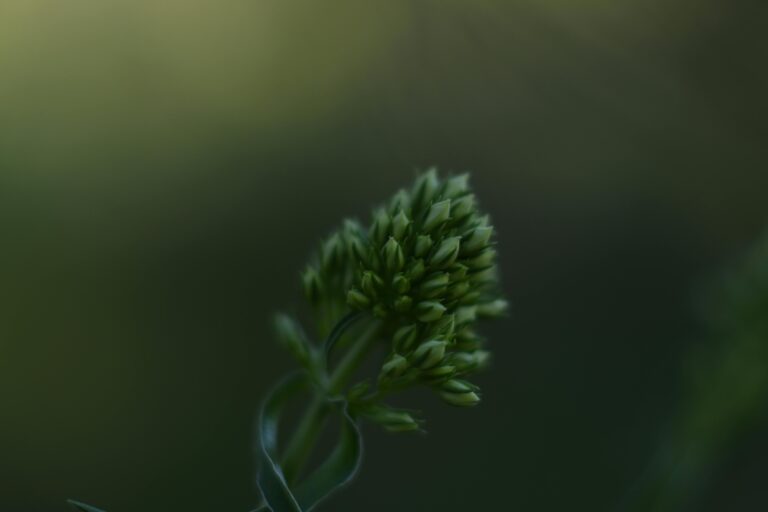
As cities sprawl and natural habits capitulate, gardens become crucial sanctuaries for wildlife—and Sedum ternatum is the perfect host. Its dense foliage offers safe haven for ground-nesters and small critters, merging beauty with utility. Opting for Sedum ternatum is like sending an open invitation to nature’s symphony, encouraging the return of native species that might otherwise be silenced in the face of urbanization.
And what about the less visible but equally important denizens of the garden? Sedum ternatum is a friend to the earthworms and microorganisms too, with its minimal needs preventing soil compaction and promoting a healthy soil biome. As an eco-friendly garden choice, it sidesteps the need for harmful chemicals, embodying the ideals of organic gardening and championing a pesticide-free ethos.
Moving the lens wider, Sedum ternatum is a marvel of sustainability. In a time when water is as precious as gold, this plant thrives on neglect, making it a dream for the conservation-conscious gardener. By planting Sedum ternatum, you contribute to water conservation efforts without sacrificing the allure of a lush, thriving garden scape.
This shade-loving sedum is not only a sanctuary for life but a reflection of our own sustainable choices. Planting Sedum ternatum is a statement, a commitment to nurturing biodiversity, and a step towards a greener future where our gardens are more than an oasis of calm—they’re a cornerstone of ecosystem recovery and resilience. So let’s embrace the understated splendor of Sedum ternatum and witness the ripple effect of positive change, from the delicate petals to the robust roots and beyond.
Frequently Asked Questions
Are you curious about the enchanting Sedum ternatum and its compatibility with your garden? Let’s dive into the most common inquiries garden enthusiasts have about this versatile plant.
Is Sedum ternatum winter hardy?
Indeed, Sedum ternatum, also recognized as Woodland Stonecrop, is a winter warrior! It’s remarkably resilient and can endure chillier temperatures, often found thriving in USDA hardiness zones 3 through 8. Imagine a serene, snowy garden, where amidst the white, the luscious green of Sedum ternatum perseveres—the very definition of winter hardiness.
How quickly does this Sedum spread?
If you’re looking for a groundcover that acts fast, look no further. The Sedum ternatum is not only swift but also a considerate spreader. It covers ground at a moderate pace without being overly aggressive—ensuring other plants aren’t overwhelmed. Envision it weaving its way through a rockery, offering a green embrace to stones and soil alike, embellishing the landscape as it grows.
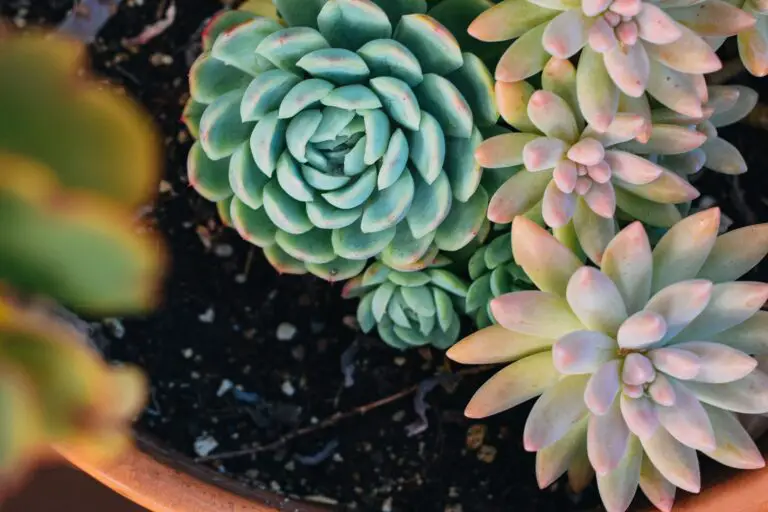
Does it play well with other plants?
Absolutely! Sedum ternatum is like the friendly neighbor of the plant world. It coexists harmoniously with ferns, hostas, and other shade-loving companions. Picture a shady nook in your garden, where Sedum ternatum is the lush, living carpet at the feet of towering hostas or the lacy fronds of ferns—a perfect picture of plant camaraderie!



